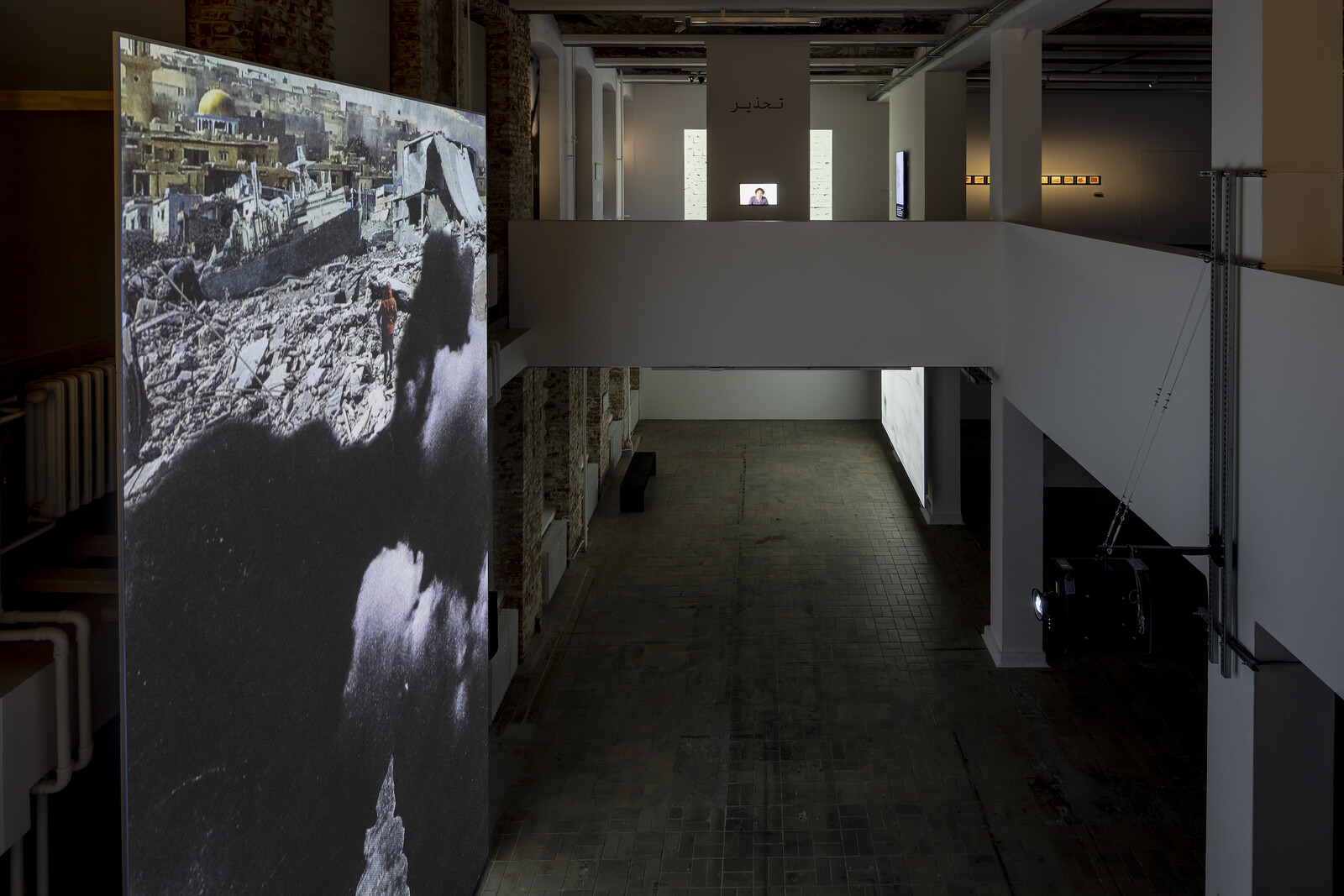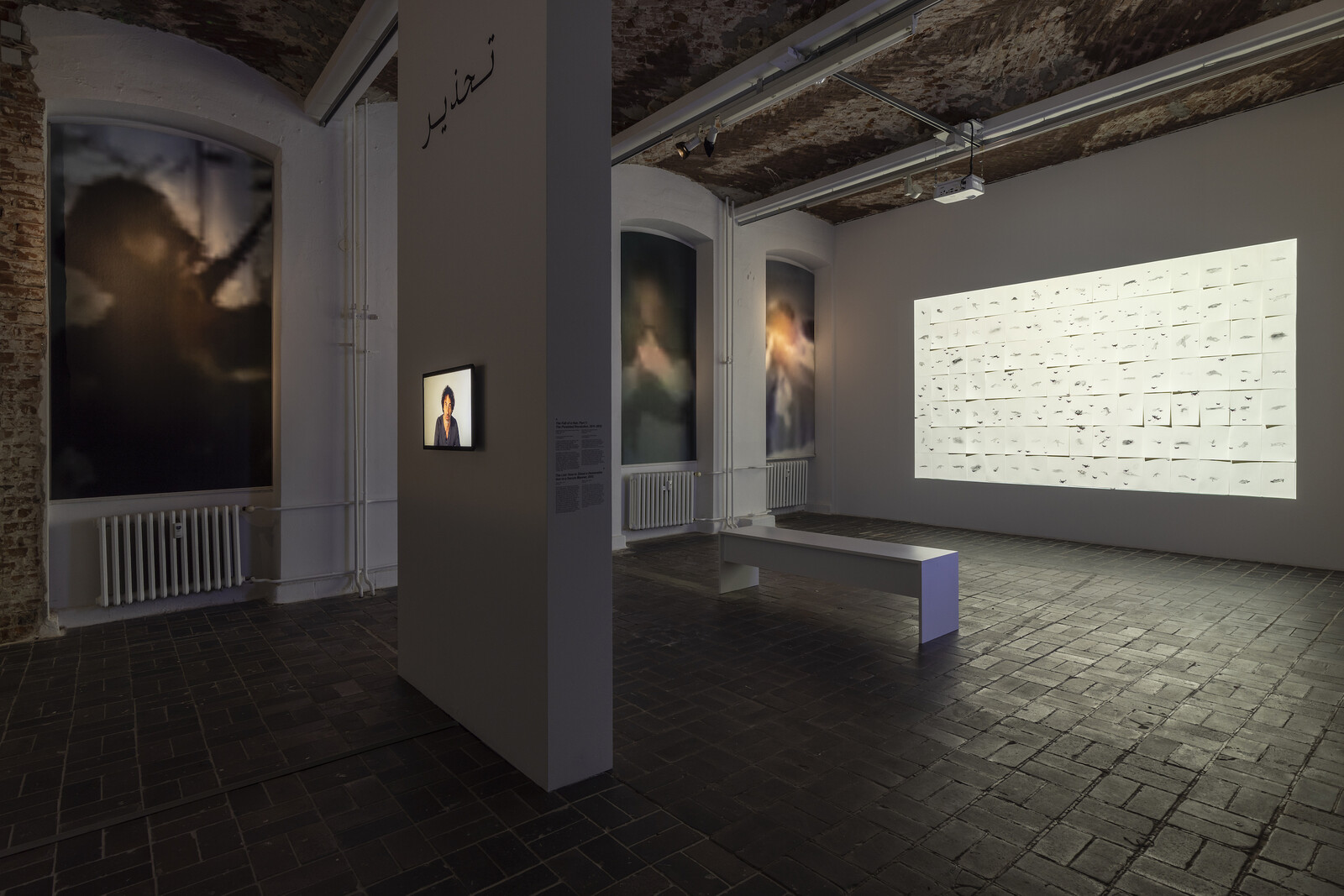“One of the main weapons is the image itself.” So proclaims Rabih Mroué in his 2018 lecture-performance Sand in the Eyes. With trademark brevity, his statement articulates the complex recurring strategies—analyzing images as weapons, conflating theatricality with war, reading revolutions through pixels—that underlie Mroué’s multidisciplinary projects as a visual artist, actor, playwright, and director. This mid-career survey, surprisingly also his first solo exhibition in Berlin, brings together two decades of work and, incredibly, eight new commissions produced largely during the pandemic.
In design and execution, its ambitions are staggering. A non-linear constellation of video projections, installations, collages, and archival material are structured around a two-story vertical video that can be seen from all corners of the exhibition’s two floors. With so many video and audio works, the sound bleeds (a plinky xylophone suggestive of a film score’s anxious denouement, punctuations of gunfire and explosions that arrive unexpectedly, the noisy insistence of a film projector) effectively recall the sonic chaos of war while still creating an integrated audio environment.
The imposing central work, Images Mon Amour (2021), loops through imagery culled from Lebanese newspapers, with the benday dots of analog print enlarged and visible. Weaponry, tanks, air patrol, bombs, cities, landscapes, and people in various states of pre-war life and post-war devastation are collaged together like geologic strata. Formally, it evokes the contemporary habits of phone scrolling, or even microfiche, the pre-digital news aggregator, and its verticality suggests aerial occupation and the threat of drone warfare. The work crystallizes an overarching position in Mroué’s oeuvre: that, across geographies and generations, through the sediment of time, war permeates life. Technologies of image-making are inseparable from conflict, and always position one as either viewer or viewed, victim or oppressor; that such positions are never fixed is the crux of Mroué’s determinately theatrical and anti-documentary stance.
Many works address the artist’s own experiences of war and its lingering aftermaths. Footnotes of an Unwritten Text About War, Body and Theatre (2014–16), for example, collects visual footnotes, or outtakes, from years of living and working in his home country Lebanon; references to civil war and displacement are frequent, but so are broader questions about living and dying and the strange commune between. The ongoing war in Syria recurs in projects that interpolate the viewer through specific conditions of presentation. Only one person at a time can experience As If Seen By a Bird Standing On a Cow (2018), a ceiling-mounted video where one looks directly up into a drone’s-eye view looking down on the wreckage of the three-year Siege of Homs, an event little reported in Western media. Leaning over to see into the 16mm film projection The Fall of a Hair, Part 4: “Eye” vs “Eye” (2012) precipitates staring into the barrel of a gun, a confrontational strategy that conjoins camera and weapon through pixelation. This kind of positioning could be heavy-handed, but isn’t. Mroué’s lilting, almost musical, way of speaking and his epistolic narratives—the gorgeous digital film collage The Other, the Unknown Other and Other Stories (2021) begins, “Dear Carol, I hope my letter finds you in good health. I’m sorry for the silence…”—lend the work genuine intimacy, as though you are listening to a friend experience these extremes of violence and dispossession.
Mroué’s careful negotiations of fact and fiction, and his expertise as an actor, are most evident in what he calls his “non-academic lectures,” live performances that take the format of an illustrated lecture while confusing the pedagogical and didactic purposes of one. Winding, looping storytelling creates a world where images are agents, facts are personal, and lines between Mroué the actor, artist, and activist all blur. It was a brilliant move to restage his older performances for video—including the acclaimed “Make Me Stop Smoking” (2006) and “The Inhabitants of Images” (2009)—and exhibit them grouped together, so the present-day Mroué appears to inhabit the ideas and arguments of his former self. One of his most effective confusions of subject comes in On Three Posters (2004). The original performance investigated an unedited videotape of martyr Jamal al-Sati giving different “takes” of testimony to be aired on Lebanese television; at its conclusion, Mroué stepped out from behind the screen, confusing the Beirut audience who assumed they were watching a recording of Mroué, a famous actor, playing the martyr. Instead, in this moment of fabrication, his reanimation of the dead became real: “Who is the spectre, the flesh or the image? I, or my picture?”
Mroué’s image epistemologies regularly confuse categories of subject, event, narrative and fiction. In the era of “fake news” and “alternative facts,” his performances take on a more urgent tenor than even a few years ago. I can’t help but think of Harun Farocki here, who in 1975–76 wrote: “What is called documentation shows the world as if it were known, which has the effect that a few years later, we can no longer experience what it looked like. Images must be made with which today’s strange world can be discovered and the present becomes history.”1 This is what Mroué does so well: constructing new narratives, new ways of seeing, such that we can critique the image regimes of the present, and anticipate the political conditions of a future that will one day historicize us.
Harun Farocki, “What Ought to be Done,” in Harun Farocki: What Ought to Be Done (Berlin: Harun Farocki Institut, 2016), 3.





